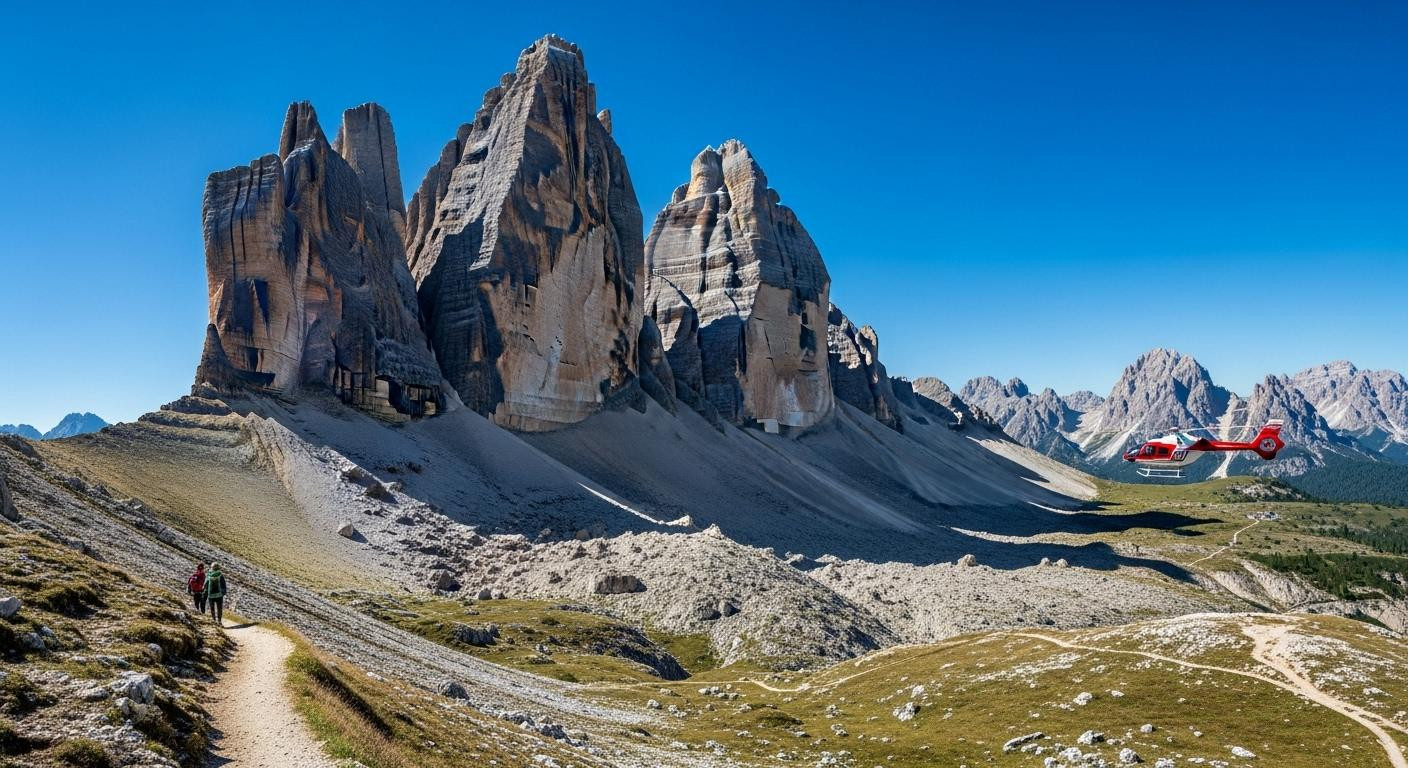Dawn breaks at 6:47 AM over Tre Cime di Lavaredo. A rescue helicopter circles limestone peaks while tourists queue for sunrise photos. Three days ago, you knew these mountains from Instagram – golden light, turquoise lakes, perfect drama. Now, standing where 83 people died this summer chasing those same shots, something fundamental shifts. This isn’t about avoiding beautiful places. It’s about understanding why experienced Alpine guides watch tourists arrive in sandals with phone batteries at 12%, and why locals no longer hike their own mountains in July and August.
The Instagram effect: when beauty becomes deadly
The numbers tell a brutal story. Between June 21 and July 23, 2025, 83 people died in the Italian Alps with 5 others missing – averaging almost 3 deaths per day. By mid-August, fatalities exceeded 100 across the Dolomites, Mont Blanc region, and Gran Paradiso. The Italian Alpine Rescue confirms rescue operations increased 20% compared to last year, with hikers comprising the highest number of victims, followed by alpinists, cyclists, and paragliders.
Morning at Cortina d’Ampezzo reveals the disconnect. Steam rises from espresso cups while mountain guides prepare ropes and check weather reports. Tourists scroll through Instagram, planning their golden hour shots for locations like the village of Ortisei where safer cultural experiences await. The transformation from 19th-century aristocratic mountain culture to 2025’s “come for the photo, leave unprepared” reality has created a deadly crisis.
The fatal mistake: what rescue services actually see
The weather pattern emerges as the primary killer. European Alps experienced unusually unstable conditions throughout summer 2025, especially during afternoons when many stormy spells swept through the region. Documented incidents include two climbers rescued at 14,435 feet on Monte Rosa during high winds and snow, hospitalized with hypothermia during what should have been summer hiking season.
Equipment gaps: sandals on via ferrata
Trail overcrowding reached crisis levels where farmers instituted visitor levies at popular spots. The surge in deaths directly correlates with increased visitor numbers, many attempting technical routes without proper equipment. A 60-year-old man fell to his death on Viel dal Pan trail near Marmolada, while a German woman died in a 330-foot fall from Colle della Lace in Aosta region.
Weather windows: 15 minutes to storm
Permafrost degradation compounds the danger. At Cima Falkner, major rock detachments forced closure of routes 305, 315, 316, and 331. Authorities described the mountain as “opening like a flower” with ongoing landslides threatening popular trails leading to Tuckett Refuge beneath Castelletto Inferiore, one of the Brenta Dolomites’ most famous peaks.
What works: how locals actually hike these mountains
Emergency ordinances now prohibit access to certain trails starting from Grostè Pass. Drone monitoring by the Trento Fire Brigade, PAT Geological Service, and Trentino Alpine Rescue indicates unprecedented geological instability affecting Instagram-famous locations.
The 4 AM start rule
Experienced Alpine hikers begin at dawn to avoid afternoon storms and empty trails. The rifugio reservation system ensures safe overnight stops, while emergency beacon rentals at trailheads provide crucial safety margins. Locals use these systems; tourists rarely do. Routes 315 and 316, the area’s most popular walking trails, recently reopened after experts concluded continuing rockfalls wouldn’t directly affect these paths.
Gear reality: what $90 actually protects
Minimum equipment includes proper boots ($65-90), via ferrata harness sets ($80), emergency whistles, and paper maps since cell service fails. The difference between Dolomites hiking (technical, exposed terrain) and Instagram’s implied accessibility creates dangerous misconceptions. Many victims ventured into mountains with pre-existing health issues, compounding rescue complications in locations like the Amalfi Coast path where winter conditions offer safer alternatives.
The choice: beauty without the body count
Italian media call the situation a “hecatombe” (massacre). The same light that dazzles on Instagram exists at 5 AM with preparation, respect, and proper gear. Mountain rescue services stress: “The mountains are always there. They’ll still be beautiful when you’re ready.” The growing tension between 10 million annual visitors and 6,000 Cortina residents who watch helicopters daily creates unsustainable pressure.
November 2025 transforms these trails into winter sports terrain requiring completely different skills. The same beauty exists, but different deadly mistakes become possible. Mountain destinations like Antigua Guatemala offer similar altitude challenges with better safety awareness protocols.
Your questions about Alpine hiking safety answered
What’s the minimum preparation for Tre Cime or Lago di Braies?
Trail research including difficulty ratings and via ferrata versus hiking path distinctions. Weather forecast verification, proper footwear, 2 liters minimum water, paper maps, and 6 AM summer starts. September through May requires avalanche beacons due to snow conditions. Emergency whistles and backup batteries remain essential year-round.
When are the Dolomites actually safe for casual hikers?
June through September for marked trails below 6,560 feet elevation, but July-August crowds create dangerous bottlenecks on via ferrata routes. May and September offer fewer crowds but unpredictable weather patterns. December through March requires winter mountaineering skills, not casual hiking experience.
How do Italian Alps compare to other deadly hiking destinations?
The 83 Italian Alps deaths exceed Annapurna’s 54 fatalities and several Arizona heat-related deaths. Italian Alps offer superior rescue infrastructure, but the psychology of safety rituals shows Instagram effects drive inexperienced hikers to technical terrain that Arizona’s desert trails don’t present.
At 6:47 AM the next morning, mist rises from Lago di Braies. A rescue helicopter idles at Cortina’s landing pad. Your boots lace tight, harness checked, weather forecast clear. The same Instagram-famous sunrise awaits, but this time you’ll descend to tell the story.
